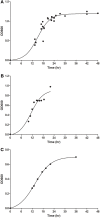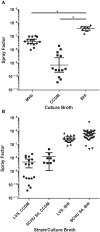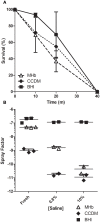Growth conditions and environmental factors impact aerosolization but not virulence of Francisella tularensis infection in mice
- PMID: 23087911
- PMCID: PMC3468843
- DOI: 10.3389/fcimb.2012.00126
Growth conditions and environmental factors impact aerosolization but not virulence of Francisella tularensis infection in mice
Abstract
In refining methodology to develop a mouse model for inhalation of Francisella tularensis, it was noted that both relative humidity and growth media impacted the aerosol concentration of the live vaccine strain (LVS) of F. tularensis. A relative humidity of less than 55% had a negative impact on the spray factor, the ratio between the concentration of LVS in the aerosol and the nebulizer. The spray factor was significantly higher for LVS grown in brain heart infusion (BHI) broth than LVS grown in Mueller-Hinton broth (MHb) or Chamberlain's chemically defined medium (CCDM). The variability between aerosol exposures was also considerably less with BHI. LVS grown in BHI survived desiccation far longer than MHb-grown or CCDM-grown LVS (~70% at 20 min for BHI compared to <50% for MHb and CCDM). Removal of the capsule by hypertonic treatment impacted the spray factor for CCDM-grown LVS or MHb-grown LVS but not BHI-grown LVS, suggesting the choice of culture media altered the adherence of the capsule to the cell membrane. The choice of growth media did not impact the LD(50) of LVS but the LD(99) of BHI-grown LVS was 1 log lower than that for MHb-grown LVS or CCDM-grown LVS. Splenomegaly was prominent in mice that succumbed to MHb- and BHI-grown LVS but not CCDM-grown LVS. Environmental factors and growth conditions should be evaluated when developing new animal models for aerosol infection, particularly for vegetative bacterial pathogens.
Keywords: Francisella tularensis; aerosol exposure; mice; respiratory infection; tularemia.
Figures









References
-
- (2002). New drug and biological drug products; evidence needed to demonstrate effectiveness of new drugs when human efficacy studies are not ethical or feasible. Final rule. Fed. Regist. 67, 37988–37998 - PubMed
-
- FDA. (2009). Guidance for Industry: Animal Models–Essential Elements to Address Efficacy Under the Animal Rule. Available online at: http://www.fda.gov/downloads/Drugs/GuidanceComplianceRegulatoryInformati...(Accessed).
-
- Bandara A. B., Champion A. E., Wang X., Berg G., Apicella M. A., McLendon M., et al. (2011). Isolation and mutagenesis of a capsule-like complex (CLC) from Francisella tularensis, and contribution of the CLC to F. tularensis virulence in mice. PLoS ONE 6:e19003 10.1371/journal.pone.0019003 - DOI - PMC - PubMed
-
- Brasel T., Agans K., Barr E., Gonzales V., Romero F., Storch S., et al. (2009). Comparison of Francisella tularensis LVS and SCHU S4 bioaerosols, in Poster Presented at: 2009 ASM Biodefense and Emerging Infectious Diseases Meeting (Baltimore, MD: ).
Publication types
MeSH terms
Substances
LinkOut - more resources
Full Text Sources
Research Materials

